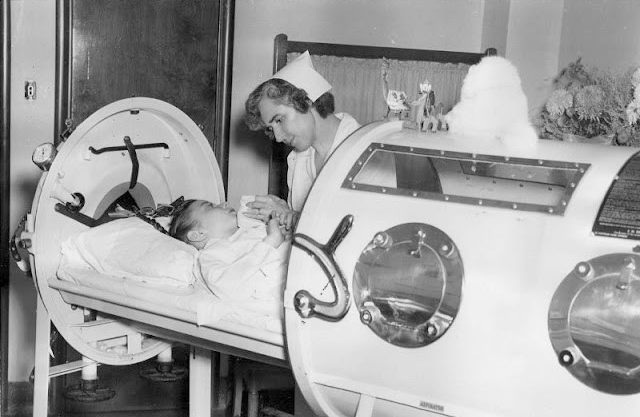
Designed by John Haven Emerson (no relation to Ralph) in the 1930s, the Emerson Lung was quieter, lighter, and less expensive to produce than the original iron lung designed by Drinker and Shaw. Devices like these were staples in hospitals for more than three decades, until Jonas Salk introduced the polio vaccine in the spring of 1953.
Many years ago, as her life was winding down, and soon before she would spend her final hours tethered to a ventilator, my mother said something I’ve never forgotten.
Breathing is one of those things you take for granted, she observed. Until you can’t.
Grasping for straws is easier, the American poet Mark O’Brien once wrote. You can see the straws.
O’Brien contracted polio when he was six years old, and the disease left him paralyzed from the neck down. He used an iron lung to breathe.
Think about that for a moment. An iron lung. A machine to breathe for you.
Like a ventilator.
Developed by two professors at the Harvard School of Public Health in the 1920s, iron lungs were assistive respirators, huge metal cylinders in which the patient was encased, and armed with bellows-like attachments: imagine suction pumps as breathing proxies, only cumbersome and terrifying. Later, they were replaced by smaller and more portable devices called ventilators which are, arguably, less terrifying.
Except when they are gone.
Today, the roughly 175,000 ventilators in all American hospitals are expected to be far fewer than needed to handle a surge of patients who, in coming weeks, will be desperate for breath. It may be easier to convince yourself that getting through this pandemic armed with meditation apps is the way to go, here. For anyone, unthinkably, continuing to hoard masks and supplies for their own, arguably selfish benefit—think again. O’Brien once described the compromised passageways through which he drew breath as “a finger’s width of the rope that ties me to life”.
A finger’s width of rope. That’s all any of us have.
Meanwhile, a global race is now underway to design and engineer new alternatives: the CoVent-19 challenge (“Innovate to Ventilate”) is one of a host of efforts looking to produce rapidly deployable ventilation solutions for patients. The Code Life challenge—a brilliant Canadian initiative—is another. Engineers at MIT are developing a manual resuscitator powered by an Arduino-controlled motor, and in the UK, Sir James Dyson’s ventilator—which he designed in a remarkable ten days—is currently in production.
You may not be a product designer, but the embedded message here is one for us all. Consider that concentrating on your own breath might not actually be the point right now. Can you make a phone call, a donation, or do something to help someone beside yourself? “To know even one life has breathed easier because you have lived,” wrote Emerson “this is to have succeeded.” Breath—that fragile finger’s width of rope— is really all we’ve got. Let’s not ever take that for granted again.
